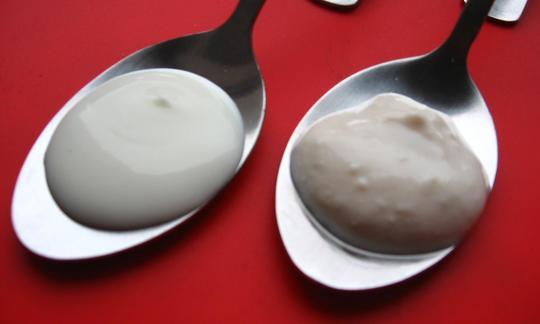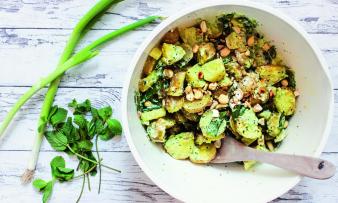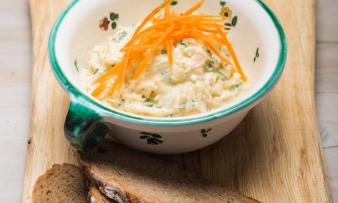Table of contents
Soy yogurt is a vegan yogurt made from cooked and fermented soy milk. Since soybeans require a heating process, the end product is never raw , but is available organically .
Use in the kitchen
What is soy yoghurt? Soy yoghurt is soy milk (made from cooked soybeans) that has been acidified with the help of special lactic acid bacteria, which then curdles and produces a firm vegan yoghurt. Natural soy yoghurt has a mild but distinct taste reminiscent of beans. However, commercial products taste different and it is worth trying some of them. Coconut yoghurt or products made from oat milk , almond milk or rice milk are similar. You can also make yoghurt from cashew nuts .
Soy yogurt is ideal for making sweet creams and salty dips. With cashew nuts , maple syrup and a little lemon juice you get a cream for vegan gateaux or pies. If you puree soy yogurt with mango , water and spices as desired (e.g.vanilla , ginger , cardamom , ...) you get a delicious mango lassi. In a high-performance blender you can make ice cream from frozen strawberries and soy yogurt. If you put soy yogurt with vanilla pudding on a tart dough you have a vegan cheesecake (raspberry cheesecake without baking can be found under the ingredientraspberries ).
Vegan soy yogurt herb dips go well with boiled potatoes or raw vegetable sticks. You can use soy yogurt with tomato paste , vegetable stock and curry powder to make a spicy sauce with vegetables and rice . Vegan "kebab doner" with lots of raw vegetables (e.g. red cabbage , tomatoes , lettuce , cucumber ) and boiled chickpeas seasoned with soy sauce , ground sesame and "fried chicken seasoning" are also delicious. The soy yogurt, salt and garlic make the basic sauce. Finally, fill a bread roll with vegetables, chickpeas and soy yogurt.
Homemade soy yoghurt
Ingredients: 1 L soy milk (preferably homemade soy milk that contains no additives), 3 tablespoons soy yoghurt (organic) or yoghurt ferment.
Utensils: Thermometer, 4 sterile screw-top jars.
Preparation: First heat the milk to 45 °C. Then add the yoghurt bacteria in the form of soy yoghurt or yoghurt ferment. The milk must not be too hot, otherwise the bacteria will die. Mix everything well and pour into the screw-top jars. You now have to keep the yoghurts warm; 37-40 °C is ideal. You can create such an "incubator" by heating the oven briefly (lowest setting) and then turning it off again. This gives you a warm, but not too hot, room for the yoghurt. Alternatively, you can work with blankets and a hot water bottle. The temperature should remain relatively evenly warm for 12 hours. Then store the yoghurt in the refrigerator.
Vegan recipe for soy spinach pancakes
Ingredients (for 6 pieces): Pancakes: 250 g whole wheat flour , ½ teaspoon salt , 1 teaspoon baking powder , 300 ml soy drink , 200 ml carbonated mineral water , a little rapeseed oil . Filling: 200 g smoked tofu , 400 g baby leaf spinach (organic, raw), 1 red onion , 2 cloves of garlic , 1 pinch of salt , 1 pinchof pepper , 100 g soy yoghurt (organic), a bunch of parsley , cocktail tomatoes .
Preparation: Put the soya drink, mineral water and salt in a large bowl. Now sift the wholemeal flour and baking powder through a fine sieve, gradually stirring in with a whisk. The dough should rest for 10 minutes. In the meantime, dice the smoked tofu and onion. Sprinkle the onion with salt and press it with your hands to "de-escalate" the onion. For the yoghurt sauce, peel the garlic and use a press to process it into a paste and add it to the yoghurt. Add finely chopped parsley and spices. Now bake the pancakes in a non-stick pan with very little oil. To do this, put a ladleful into the hot pan that has been brushed with oil. Spread the batter evenly in the pan by gently swirling. Bake on both sides until golden brown. When all the pancakes are ready, fill with spinach, onion, tofu and soy yoghurt sauce and serve.
Vegan recipes with soy yoghurt can be found under the note: " Recipes that have the most of this ingredient ".
| Not only vegans or vegetarians should read this: Vegans often eat unhealthily. Avoidable nutritional mistakes . |
Purchasing - Storage
Soya yoghurt, often from organic farming, can be found at major retailers such as Coop , Migros , Denner , Volg , Spar , Aldi , Lidl , Rewe , Edeka , Hofer , Billa etc. Organic supermarkets such as Denn's Biomarkt or Alnatura , but also health food stores, drugstores or specialty shops offer a larger selection of different soya yoghurts. Pay attention to the list of ingredients, because even natural soya yoghurt can contain sugar or other unnecessary additives. Soya yoghurt with flavor (e.g. vanilla) is usually sweetened.
For the homemade version, you can often buy dried soybeans directly from regional organic farmers. Otherwise, you can also find soybeans (organic) in many online shops.
The availability of soy yoghurt varies depending on the size of the store, catchment area, etc. You can find our recorded food prices for the DA-CH countries above under the ingredient image - and by clicking you can see their development at different suppliers.
Storage tips
Soy yogurt (without additives) will stay edible for around 10 days in the fridge (7±2 °C) and four days at room temperature (27±3 °C). You can smell and see whether bad bacteria or fungi have taken over in the yogurt. Due to the acidic environment in yogurt, mold and yeast are the main fungi that form during spoilage. A smell of yeast and/or settled water (curdling of the yogurt) are signs that the yogurt is no longer good. 12,14
Yoghurt has a relatively long shelf life when sealed due to the bacteria it contains. There are a few things to keep in mind: Always use a fresh spoon and transfer to another container if you do not intend to eat the whole yoghurt at once. If microorganisms from our mouths get into the yoghurt, yeast in particular can multiply rapidly and cause the soy yoghurt to spoil. It is also advisable to always seal the yoghurt tightly. Mold and yeast can also get into the yoghurt via the air. 13,14
Ingredients - Nutritional values - Calories
100 g of soya yoghurt contains 27 kcal of energy. 100 g of soya yoghurt contains 3.5 g protein, 0.7 g fat and 2.7 g carbohydrates. 11
A significant essential nutrient in soy yoghurt is vitamin E. 100 g of soy yoghurt contains 20% (2.4 mg) of the daily requirement, a similar amount todried pumpkin seeds . You can get more vitamin E from raw sunflower seeds . One tablespoon (approx. 10 g) contains 3.5 mg of vitamin E - more than 1⁄3 of the daily requirement. 11,16
Tryptophan is an essential amino acid, which is contained in 100 g of soy yoghurt at 0.05 g. Compared to whole cooked soybeans , which cover almost (98%) of the daily requirement with 100 g, this is a small amount. Hemp seeds (0.37 g/100g) or linseed (0.30 g/100g) contain much more than soy. 11,16
The third most important ingredient in soy yogurt is folic acid . A 100-g portion of soy yogurt contains 36 µg of folic acid, which is comparable to pine nuts . Soy granules have a significantly higher value than soy yogurt at 390 µg/100g. 11,16
100 g of soy yoghurt contains 170 mg of potassium . Raw white cabbage or lychees can provide the same amount of potassium. Almost three times as much is contained in cooked soybeans (515 mg/100g) and even more is contained in roasted pistachios (1007 mg/100g). 11,16
The nutritional value of soy yoghurt is mainly due to the protein quality and the probiotic effects of the yoghurt bacteria. 22
You can find all the ingredients of soy yoghurt, the coverage of the daily requirement and comparison values with other ingredients in our nutrient tables. In the article Nutrients explained you will get a detailed insight into the topic.
Effects on health
In recent decades, scientists have published an enormous number of research results on soy as a food. It turns out that soy has not yet been fully researched. Much is still unclear and in some cases even ambiguous. 1
The fat composition is an interesting aspect of soy from a health perspective. Omega-6 and Omega-3 fatty acids are essential for humans. Omega-6 is ubiquitous in the modern diet, and we tend to consume too much of it. Omega-3 is much rarer (fish, linseed , walnuts , etc.). In general, only a few plants contain these polyunsaturated fatty acids . Soy yoghurt contains 0.06 g/100 g of omega-3 (alpha-linolenic acid 'ALA') (3% of the daily requirement) and 0.38 g/100 g of omega-6 (linoleic acid 'LA') (4.0%). This corresponds to a ratio of around 5:1. 11 Studies suggest that a low LA:ALA ratio has anti-inflammatory effects. It is thought that the anti-inflammatory properties are due to a higher intake of ALA, not a lower intake of LA. Inflammation in the body can cause narrowing of the heart vessels (atherosclerotic cardiovascular disease). The ratio of soy yogurt is not optimal, but better than the average Western diet with LA:ALA=15–20 (eg 15:1). 18,20 There is also evidence that soy has a negative effect on the further processing of omega-3 fatty acids. People who eat a lot of soy should pay particular attention to ensuring they have an adequate supply of omega-3. 21
Soy owes its good reputation to its high protein quality, among other things. Protein quality is determined by the composition of the amino acids and their digestibility. 22 Soy milk, and therefore also soy yoghurt, contains almost all essential amino acids and is easily digestible by humans. But getting enough protein does not seem to be a problem for many people: A study of 14 industrialized countries showed that, regardless of demographic factors and lifestyle, protein intake consistently accounted for 16% of total energy - that is about twice the recommended amount of protein for adults. 1
The fermentation required for soy yogurt is said to have a positive effect on health. Fermentation refers to the microbial conversion of organic substances. Many studies indicate that fermented foods made from soy are very healthy. However, in order to declare nutritional recommendations, well-designed, complex human studies are needed. Their diet, lifestyle, family background and medical history must be recorded precisely. In addition, long-term follow-up observations of the individual test subjects are required. 2 One factor that has received more attention in recent years is the connection between yogurt and our intestinal bacteria. Yogurt, including soy yogurt, could help with weight loss. Our intestinal microbiome is probably connected to our body weight. Probiotics are living microorganisms that provide the host with health benefits. The probiotics contained in soy yogurt could have a positive effect on weight regulation; or at least a positive effect on the intestinal flora. 25
The lactic acid bacteria that turn soy milk into soy yogurt produce antioxidant substances. Oxidative damage in the body can accelerate the aging process and is linked to various diseases (cancer, diabetes, high blood pressure, atherosclerosis). 24
How healthy is soy yogurt? Soy yogurt provides high-quality proteins and bacteria that are good for our "stomach". (For more information on the health effects of soy, see the ingredient soy milk .) Studies have also shown that soy yogurt has an antioxidant effect. The bioactive ingredients of soy can have either a positive or negative effect, depending on the physiological state of the consumer. Soy isoflavones can have estrogenic and antithyroid effects in animals and humans, which can be either beneficial or detrimental depending on the constitution. 24
How much soy yogurt per day is healthy? Soy is a very nutritious plant. Therefore, the plant has to protect itself from predators. The plant produces defensive substances that can be bad for us. Cooking, germination and fermentation are methods to make soy more digestible. 7,28 Despite all this, some of these substances can still be present in soy yogurt. Exact dosage recommendations are hard to find, but it seems to be good advice not to eat too many soy products, to pay attention to quality and individual predispositions and digestibility.
Dangers - Intolerances - Side effects
Caution is advised in cases of estrogen-dependent diseases or thyroid diseases. Unfortunately, we were unable to find any clear statements on this during our research. 26
Soy is one of the eight most common food allergens. 27 Pollen-associated food allergies to soy are also common: patients are allergic to pollen from birch, hazel or alder, but can react to soy due to its similarity to certain soy proteins. Processing (heating, fermentation) can make soy products more tolerable, but this must be checked on an individual basis. 31
Use as a recognized medicinal plant
Certain lipids from soybeans, which are also found in soy milk 29 , the soy phospholipids (Lecithinum ex soja), are used as a drug. There is a positive monograph from Commission E . 30 Soy lecithin is used for mild lipid metabolism disorders. 15
Ecological footprint - animal welfare
Global food production is responsible for approximately 26% of all annual greenhouse gas emissions. One of the biggest drivers of greenhouse gases in food production is dairy products. 5 Plant-based milk substitutes, such as soy yogurt, can have a positive impact on this ecological balance. We could not find any concrete figures for soy yogurt, but soy milk has a CO 2 footprint of 0.525 kg CO 2 eq/L. 32
A large proportion of soy is grown on conventional land using herbicides and genetic engineering. 3 Some of it is also grown in cleared rainforests. 4 In addition to the obvious threats to biodiversity, there is also the question of the direct effect of herbicides on humans. There are different results on this:
The elements and phytochemicals contained in organic soybeans are reported to be richer than non-organic soybeans. In a study of four conventional soybean samples and six organic soybean samples in Malaysia, no significant differences were found. 9
In another study, samples of organic soybeans had a more favorable nutritional profile than conventional and genetically modified industrial soybeans. The researchers stress that a detailed investigation of pesticide residues is important. The lack of data on pesticide residues in important crops is a serious knowledge gap with potential consequences for human and animal health. Genetically modified soy for the use of glyphosate ('Roundup Ready GM-soy') can contain high levels of glyphosate residues. Different agricultural practices can also affect the nutrient composition of soybeans. 10
For more information on the ecological footprint, see the ingredients soybean and soy milk .
Worldwide presence - cultivation
Fermented soy foods have been a staple in Asia for centuries. Due to consumer demand, they are now available all over the world. 2
The idea of producing yogurt from soy milk originated with Li Yu-ying , a notable Chinese scientist and pioneer of soy foods, who established a soy food factory called Usine de la Caseo-Sojaine on the northwest outskirts of Paris, France, in late 1910. In December 1910, he applied for a British patent entitled "Vegetable milk and its derivatives." Li Yu-ying was granted his patent in 1912. 17
Information on growing and harvesting soybeans can be found in this article.
Industrial production
How is soy yogurt made? The starter cultures commonly used to make fermented soy milk contain Lactobacillus and Bifidobacteria . However, the addition of Streptococcus and Saccharomyces has been shown to improve the viability of the probiotics and shorten fermentation times. Soy milk is inoculated with a lactic acid bacteria culture and 'incubated' for 8-24 hours at 37 °C. 2
The bacteria in soy yogurt are primarily Lactobacillus delbrueckii subsp. bulgaricus and Streptococcus thermophilus . Lactic acid bacteria (LAB) have been used for thousands of years to ferment a variety of foods, producing organic acids and flavor compounds. Due to the increasing interest in plant-based foods in recent decades, LAB is also used for plant-based fermentation. However, the LAB strains used in lactic fermentation are usually suboptimal for the metabolism of plant substrates. Researchers are looking for alternative strains and optimal processing to promote good nutrients and minimize antinutrients. 5, 6,23
Soy yogurt is often stabilized with thickeners to achieve a firmer consistency. Another common additive is calcium . 4
Further information
Coconut yogurt, soy yogurt or natural cow's yogurt - which is the best choice? One study found that dairy yogurt had the highest protein content, with the exception of one review in which the average protein content of soy yogurt was higher. Low-fat and fat-free dairy yogurts contained significantly higher protein content than all other yogurts. In addition, plant-based proteins do not meet the definition of a complete protein because they lack essential amino acids. Plant-based yogurts contain less total sugar, less sodium and more fiber than dairy yogurts, but also: less protein, calcium and potassium.
A nutrient assessment found that oat yogurts were most similar to low-fat and fat-free dairy yogurts in terms of the key nutrients provided by dairy yogurts. When considering the nutrient and energy density of commercial yogurts, oat and almond yogurts appeared to be similar or even better than dairy yogurts, while cashew yogurts were similar to low-fat and fat-free dairy yogurts. Coconut had the lowest nutrient density and the highest energy density. Fortification with vitamins and minerals has the potential to improve the nutritional profile (e.g. calcium and vitamin B 12 ). The current strategy of replacing conventional dairy products with plant-based products must take into account the desirable nutritional benefits of dairy yogurt, such as protein, vitamin B 12 and calcium, and the minimization of nutrients such as total sugars, sodium and saturated fats. 19
Alternative names
In the EU, soya yoghurt, like soya milk , cannot be sold under this name. This gives rise to various names such as 'Yofu' or 'Sojag(h)urt'. In English, soya yoghurt is called 'soygurt', 'soy yogurt'. In New Zealand, Great Britain and Australia, the spellings 'yoghurt' and 'yoghourt' are also common.











Comments